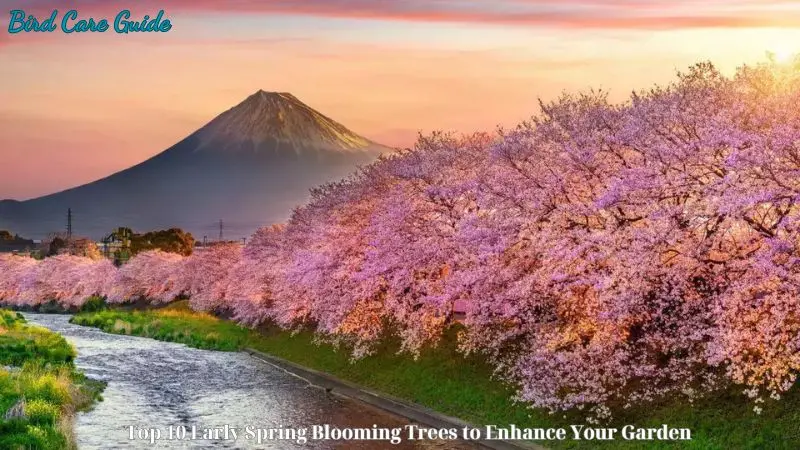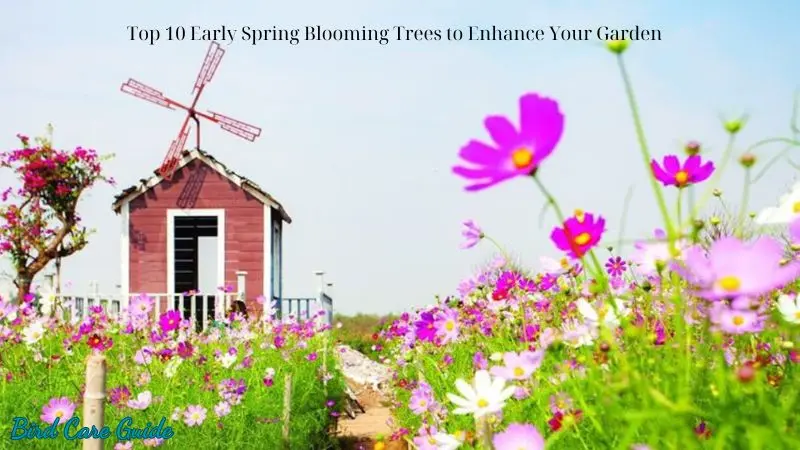The arrival of early spring is a magical time in the garden. As the last vestiges of winter fade, early spring blooming trees burst into bloom, transforming landscapes with their vibrant colors and fragrant blossoms. These trees not only signal the start of a new growing season but also provide essential nectar for pollinators emerging from hibernation. In this article, Bird Care Guide will explore the top 10 early spring blooming plants that can adorn your garden with their beauty and ecological benefits.
Top 10 Early Spring Blooming Trees to Enhance Your Garden
1. Magnolia (Magnolia spp.)
Magnolias are renowned for their stunning, large blossoms that appear before the leaves in early spring. These trees come in various species and hybrids, offering a range of colors from white and pink to purple and yellow.
- Popular Varieties: Saucer Magnolia (Magnolia x soulangeana), Star Magnolia (Magnolia stellata)
- Growth Conditions: Magnolias thrive in well-drained, slightly acidic soil and full sun to partial shade.
- Highlights: The large, fragrant flowers attract bees and other pollinators, making magnolias a valuable addition to any garden.
2. Cherry Blossom (Prunus serrulata)

Cherry blossoms are synonymous with the arrival of spring. Their delicate pink or white flowers create a breathtaking display, often celebrated in festivals around the world.
- Popular Varieties: Yoshino Cherry (Prunus x yedoensis), Kwanzan Cherry (Prunus serrulata ‘Kanzan’)
- Growth Conditions: Cherry blossoms prefer well-drained soil and full sun.
- Highlights: The short-lived yet spectacular bloom period attracts photographers and nature lovers alike.
3. Redbud (Cercis canadensis)
Redbuds are known for their clusters of small, rosy-pink flowers that cover the branches in early spring. These trees add a pop of color to the landscape before their heart-shaped leaves emerge.
- Popular Varieties: Eastern Redbud (Cercis canadensis), Forest Pansy Redbud (Cercis canadensis ‘Forest Pansy’)
- Growth Conditions: Redbuds grow best in well-drained soil and full sun to partial shade.
- Highlights: The vibrant flowers attract butterflies and bees, providing an early nectar source.
4. Dogwood (Cornus florida)
Dogwoods are a favorite for their graceful branches and showy bracts that surround the true flowers. The bracts come in shades of white, pink, and red, creating a stunning spring display.
- Popular Varieties: Flowering Dogwood (Cornus florida), Kousa Dogwood (Cornus kousa)
- Growth Conditions: Dogwoods prefer well-drained, acidic soil and partial shade to full sun.
- Highlights: In addition to their spring beauty, dogwoods provide berries for birds in the fall.
5. Serviceberry (Amelanchier spp.)
Serviceberries are versatile trees that offer year-round interest. In early spring, they produce clusters of white flowers that are followed by edible berries and vibrant fall foliage.
- Popular Varieties: Downy Serviceberry (Amelanchier arborea), Shadblow Serviceberry (Amelanchier canadensis)
- Growth Conditions: Serviceberries thrive in well-drained soil and full sun to partial shade.
- Highlights: The berries are a favorite of birds and can be used in jams and desserts.
6. Flowering Quince (Chaenomeles spp.)
Flowering quince is a hardy shrub that can be trained as a small tree. Its vibrant red, pink, or orange flowers appear in early spring, adding a splash of color to the garden.
- Popular Varieties: Texas Scarlet (Chaenomeles x superba ‘Texas Scarlet’), Crimson and Gold (Chaenomeles x superba ‘Crimson and Gold’)
- Growth Conditions: Flowering quince prefers well-drained soil and full sun to partial shade.
- Highlights: The thorny branches make it a good choice for a natural barrier or hedge.
7. Hawthorn (Crataegus spp.)
Hawthorns are small trees that produce clusters of white or pink flowers in early spring. They are known for their attractive, lobed leaves and bright red berries in the fall.
- Popular Varieties: Washington Hawthorn (Crataegus phaenopyrum), English Hawthorn (Crataegus laevigata)
- Growth Conditions: Hawthorns thrive in well-drained soil and full sun.
- Highlights: The dense foliage and thorny branches provide excellent shelter and nesting sites for birds.
8. Forsythia (Forsythia spp.)
Forsythia is a deciduous shrub that can be trained as a small tree. Its bright yellow flowers are among the first to bloom in early spring, creating a cheerful display.
- Popular Varieties: Border Forsythia (Forsythia x intermedia), Weeping Forsythia (Forsythia suspensa)
- Growth Conditions: Forsythia prefers well-drained soil and full sun to partial shade.
- Highlights: The early blooms provide an important nectar source for emerging pollinators.
9. Japanese Apricot (Prunus mume)
Japanese apricots are prized for their fragrant, pink or white flowers that bloom in late winter to early spring. These small trees add a touch of elegance to any garden.
- Popular Varieties: Mume Apricot (Prunus mume), Kobai (Prunus mume ‘Kobai’)
- Growth Conditions: Japanese apricots thrive in well-drained soil and full sun.
- Highlights: The early blossoms and sweet fragrance make Japanese apricots a favorite in traditional Japanese gardens.
10. Star Magnolia (Magnolia stellata)
Star magnolias are known for their star-shaped, fragrant white flowers that bloom in early spring. These small trees are perfect for adding a touch of elegance to any garden.
- Popular Varieties: Royal Star (Magnolia stellata ‘Royal Star’), Waterlily (Magnolia stellata ‘Waterlily’)
- Growth Conditions: Star magnolias prefer well-drained, slightly acidic soil and full sun to partial shade.
- Highlights: The delicate, fragrant flowers provide an early feast for pollinators and add beauty to the garden.
Planting and Care Tips for Early Spring Blooming Trees
To ensure the success of your early spring blooming trees, consider the following planting and care tips:
1. Site Selection
Choose a site that provides the right conditions for your tree species. Most early spring blooming trees prefer well-drained soil and full sun to partial shade. Consider the mature size of the tree and ensure it has enough space to grow without crowding.
2. Soil Preparation
Prepare the planting site by loosening the soil and adding organic matter, such as compost, to improve drainage and fertility. Avoid planting trees in heavy clay or waterlogged soil, as this can lead to root rot.
3. Planting
Plant your tree in the fall or early spring to give it time to establish roots before the growing season. Dig a hole that is twice as wide and as deep as the root ball. Place the tree in the hole, making sure the root collar is level with the soil surface. Backfill with soil and water thoroughly.
4. Watering
Water newly planted trees regularly during the first growing season to help establish a strong root system. Once established, most early spring blooming trees are relatively drought-tolerant but will benefit from occasional deep watering during dry periods.
5. Mulching
Apply a layer of mulch around the base of the tree to conserve moisture, regulate soil temperature, and suppress weeds. Keep the mulch a few inches away from the trunk to prevent rot.
6. Pruning
Prune early spring blooming trees after they have finished flowering to maintain their shape and remove any dead or diseased branches. Avoid heavy pruning, as this can reduce the number of blooms the following year.
Benefits of Early Spring Blooming Trees
Incorporating early spring blooming trees into your garden offers numerous benefits:
1. Seasonal Interest
These trees provide a burst of color and fragrance at a time when the garden is just waking up from winter dormancy. Their early blooms set the stage for the rest of the growing season.
2. Ecological Value
Early spring blooming trees are essential for pollinators, providing a vital source of nectar and pollen when other food sources are scarce. They also offer habitat and nesting sites for birds and other wildlife.
3. Aesthetic Appeal
The vibrant colors and delicate blossoms of early spring blooming trees add visual interest and beauty to the landscape. They can be used as focal points, hedges, or backdrop plantings to enhance the overall design of your garden.
4. Increased Property Value
A well-designed garden with a variety of blooming trees can increase the curb appeal and value of your property. Early spring blooming trees, with their striking flowers, are particularly attractive to potential buyers.
Conclusion
Early spring blooming trees are a wonderful addition to any garden, offering beauty, fragrance, and ecological benefits. From the elegant magnolia to the cheerful forsythia, there is a tree to suit every taste and garden style. By selecting the right species for your site and providing proper care, you can enjoy a spectacular display of early blooms year after year. So, enhance your garden with these top 10 early spring blooming trees and welcome the new season in style.





